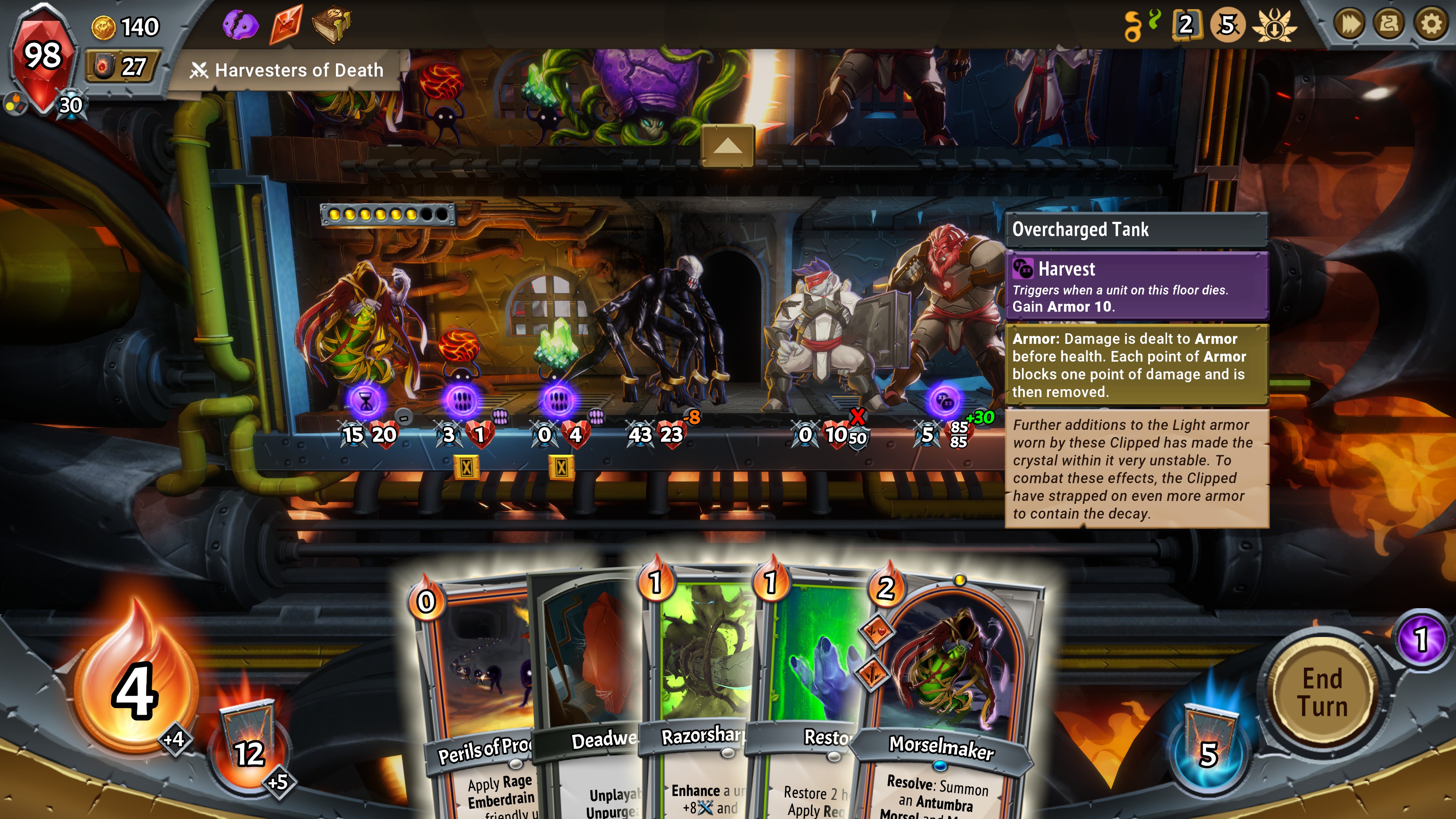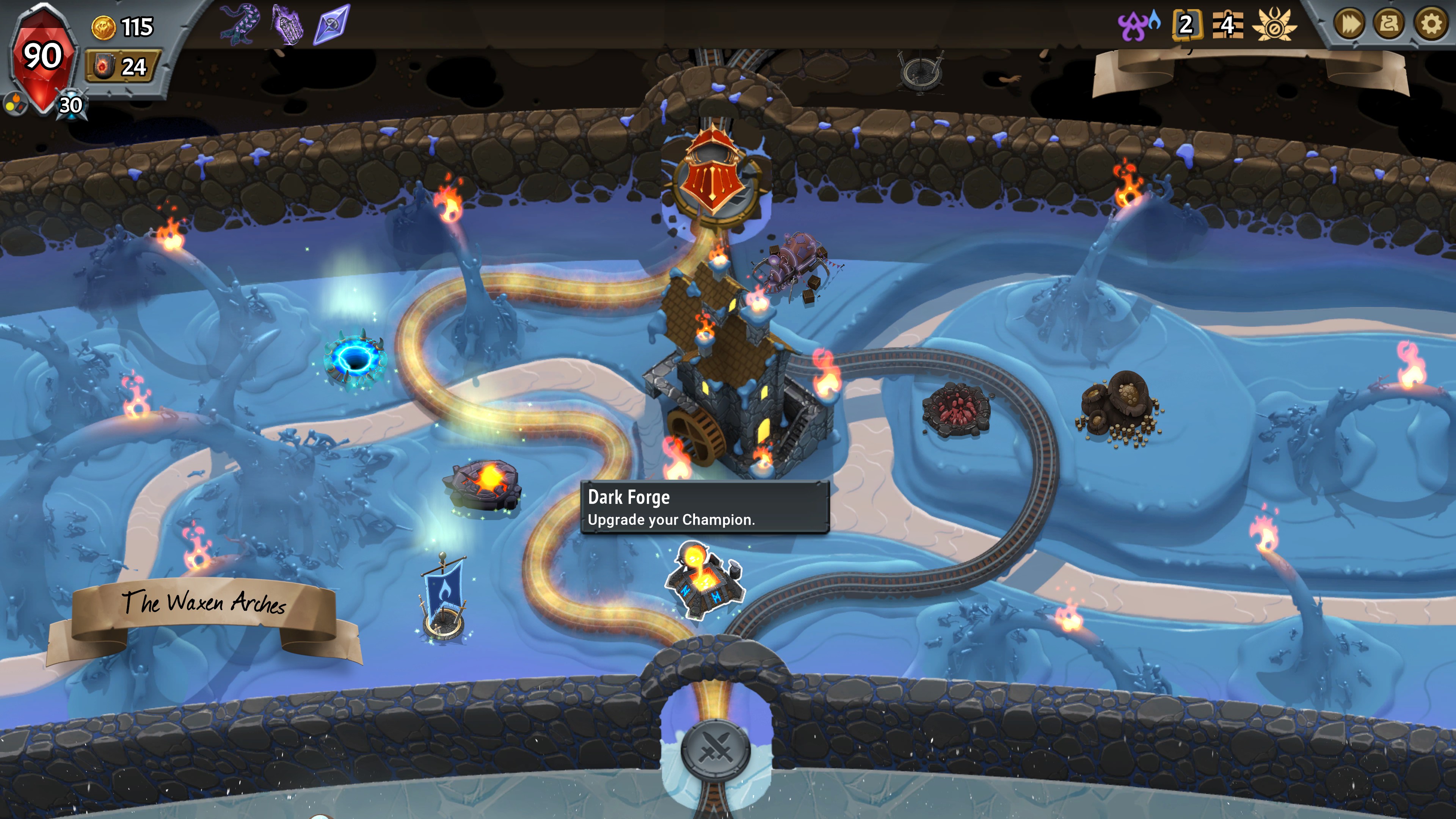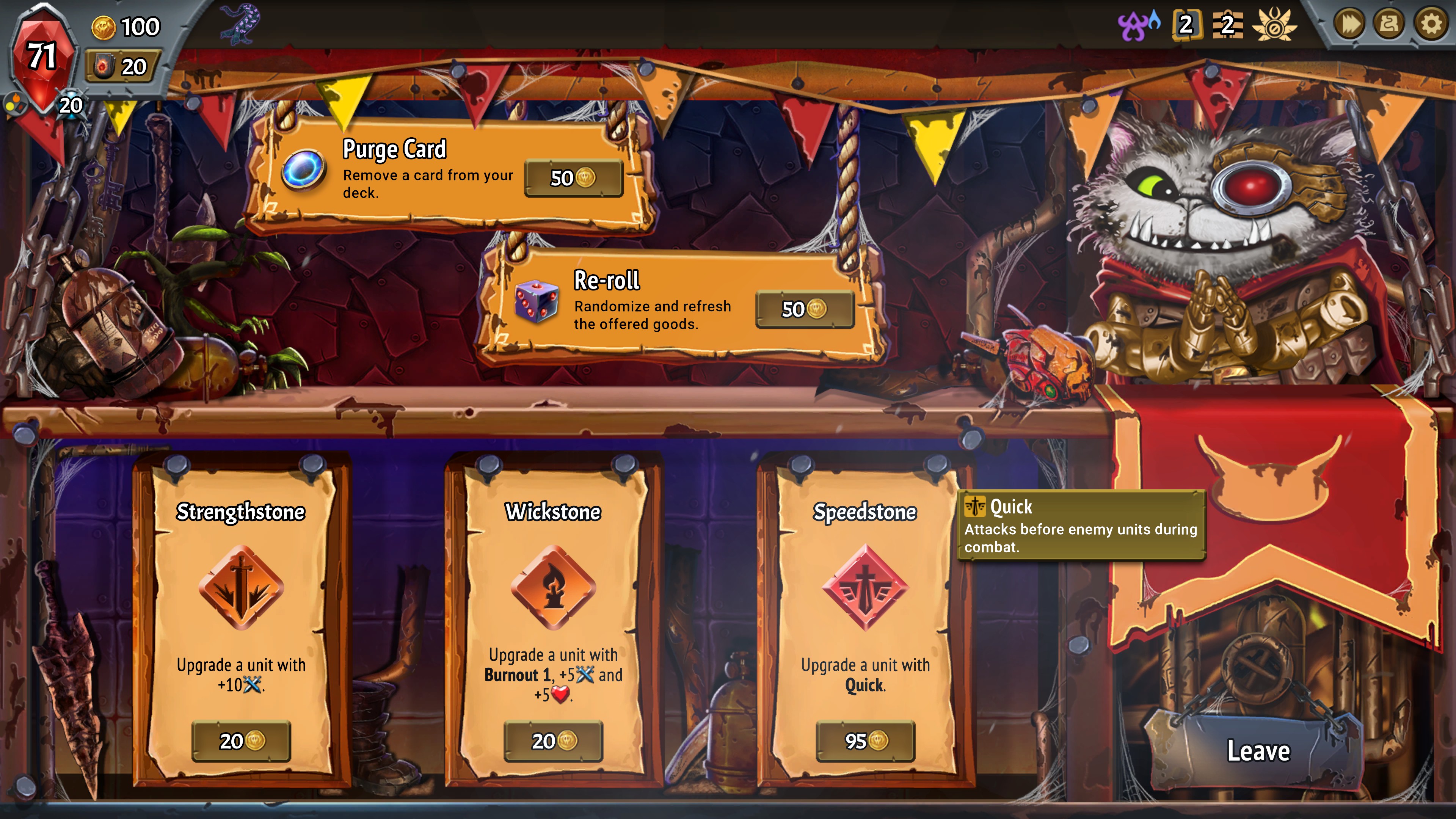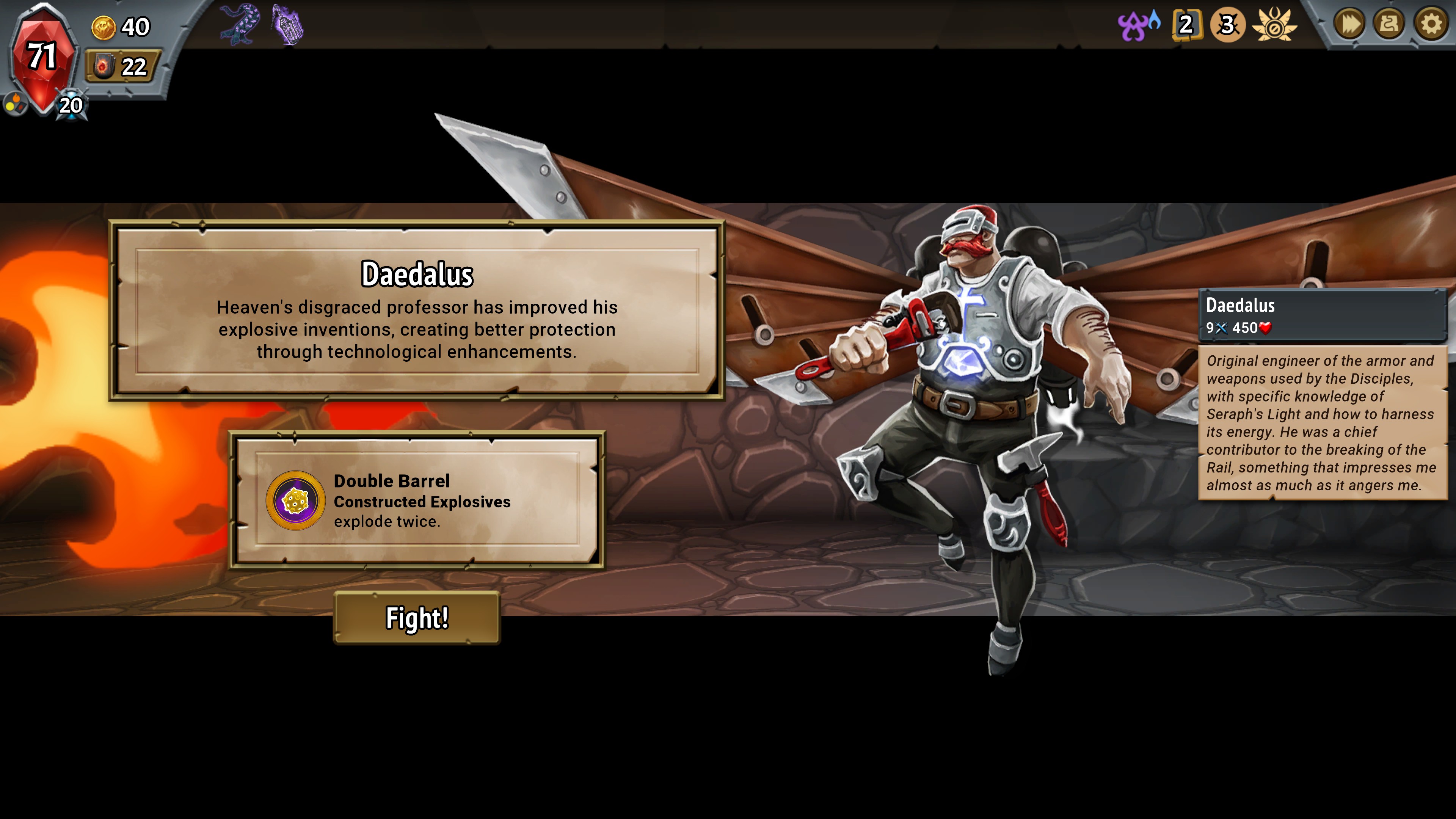Monster Train Review
I already know the outcome of the battle, the giant, winged boss Seraph crushing my fiercest warriors in a flurry of attacks back and forth. With my cards played, I hold down the right mouse button to speed through fight, relinquishing once that floor is destroyed and the boss moves up a level, getting close the precious cargo I must protect on the train.
I draw a new hand of cards, hoping for a miracle, but knowing I’ll come up just short. Seraph destroys another floor, his health battered down, but not nearly enough. I can only watch as he reaches the top, destroying the Pyre I had to keep burning.
I look at the time: late. Very late. But I want to try out another strategy, cards I had to pass up since they did not fit in the last deck. This time, this time I’ll get the winged traitor. Just one more run…
This is Monster Train, a roguelike deckbuilder where you draft cards to play spells and creatures to defend your 3 floor train from constant attack. The game combines the randomness, single life, and replayability of roguelikes with card games, but you face off against the computer rather than another human directly. As you progress in a playthrough (run) you are given options to upgrade and remove cards, constantly trying to make your deck better to survive each round of enemies and bosses.
“Just one more run” is exactly what I want to hear to know if a roguelike is worth the investment, knowing there will be some bleary-eyed mornings ahead. Monster Train nails that feeling. While there is room for improvement, there’s still a lot more for me to see after quickly hitting 20 hours of playtime.
The game is out now on Steam with a 10% launch discount (20% if you own Slay the Spire) until June 4th, with a base price of $24.99. I’ll spare you the train puns (the name is…not the best), so let’s hop on board this review, no ticket required (whoops).

Does this train run Linux?
Monster Train works flawlessly for me through Proton, and that seems to be the case more widely, based on early ProtonDB reports. The only small issue is the opening cinematic and credits not working, though you can open the mp4 files directly (typically ~/.steam/steam/steamapps/common/Monster Train/MonsterTrain_Data/StreamingAssets/).
As you might expect, the game is not too demanding: on my older desktop with a GeForce GTX 970 and Intel i5-4690K, I’m running at 60 fps at a 4K resolution. On my laptop, a Dell XPS 9550 with a GTX 960M, 4K chugs a bit in the ~20 fps range but easily remedied with playing in a smaller window. This is something Wine, Proton, and Steam have made so easy: playing a game at launch on Linux without fiddling. Plans from the developers for other platforms are forthcoming, so hopefully this Unity game will be an easy port to Linux (or perhaps official Proton whitelisting).
It’s like Slay the Spire, but…
An obvious point of comparison is Slay the Spire, the monster hit (that’s not a train pun at least) deckbuilding game from 2019. I’ve sunk many an hour into Spire, so of course a similar sounding game piqued my interest. But I didn’t want the same thing with a new skin; I could just play Slay the Spire which hasn’t grown old even after many hours.
Monster Train was certainly influenced by Spire (the devs of both games even streamed a Q&A together while playing Monster Train), but Monster Train should be appreciated on its own as a progression of the genre. And like Spire, both games have elements that might turn off the casual onlooker, whether art, style, or name; these are games where gameplay rules supreme.
There are plenty of familiar elements, but Monster Train brings enough new stuff to the table to feel different and enticing in its own way. As a Spire fan, I found a lot that translates (Poison is Frostbite, relics are artifacts, card upgrades), some elements that are just a little different (availability of card removal, types of encounters), and plenty to discover (the way combat works, clan combinations, new mechanics). It does not feel derivative, and if anything, has me wanting to go back to Slay the Spire at the same time.
Put simply, I love Slay the Spire and Monster Train is hitting a similar sweet spot of challenging and deep gameplay.
Riding the train
The basic setup of Monster Train is that you are trying to rekindle the fires of Hell by carrying the last Pyre on your train, which you must defend from invaders across 3 floors through the 9 circles of Hell. This is a roguelike deckbuilder with some tower defense thrown in: available cards, upgrades, and enemy variations are random as you build up your deck of cards (spells, creatures), with you having but one life before the run ends. You unlock cards and artifacts (persistent effects) as you play, with 2 clans (card factions) out of 5 available to start. Difficulty progresses through Covenent Ranks which modify the entire run, as well as the option of giving a bonus to enemies before a battle with a greater points and gold for defeating them (for example, a bonus to their attack).
There are some twists that Monster Train brings to the deckbuilding formula which make it feel different in this popular genre. Combat is turn-based except for bosses which play out continuously until a floor is cleared (or the boss is defeated), and positioning of units front/back is important strategically, as well as limited movement between floors. You pick two clans for each deck with the primary determining your champion, a powerful creature you start with, while you can add cards from both clans pretty equally. This means there are 20 combinations and they play very differently. The Pyre you are protecting has health and can attack, with upgrades and some spells working only on the floor just below it.

The clan variety is big strength of Monster Train, with each completely changing how you can play the game. From the Rage (damage buff) of the Hellhorned to the healing and Spikes (damage to enemy attackers) of the plant-like Awoken, I felt a familiarity in my first hours. Then I unlocked the Umbra, a clan which feeds on their own units (cute and aptly named Morsels). The tiny Morsels don’t do much on their own until they are eaten by another unit, but they go to the unit you have in front. So while positioning always matters for who can be a blocker for the units behind, now you have to balance that with ones that might get a bonus from the Morsels, but be weaker to start. Then maybe you get a unit that doubles the Morsels created. Add to that synergies with the other clans (say a bonus on unit death), and you can start to see the possibilities.
As you progress through each level, you face one battle at each stop, a few of which feature a powerful boss that buffs their minions before joining the battle in the end, and in between you have the choice of upgrades. Cards can be upgraded several times, providing permanent boosts to damage, health, or effects, turning even basic cards into powerful parts of your deck. You must also weigh deck consistency, of being able to draw what you need, through removing cards or even skipping card rewards after battles. There are some abilities, like Frozen (card stays in your hand until used) and Holdover (you draw the card again if played), as well as draw mechanics, to lend some control, but ultimately there is a random factor like any card game.

Sometimes, though, you can make good on a sure thing. For a long while I looked at Stealth (units can’t be attacked, but still deal their own damage) with envy, especially as enemies used it to chew through mine with ease. Then I unlocked the card “Engulfed in Smoke” which gives your units Stealth, from the Melting Remnant clan of wax creatures (smoke, candles, all makes sense). Upgrade it with Holdover and reduced cost, and suddenly every turn is…stealthy. A combo that can help carry a deck, though Stealth on its own doesn’t ensure you will win (as I sadly found out, coming up short on damage output).

Online features
Similar to Slay the Spire and other related games, Monster Train is singleplayer focused with online features for leaderboards and daily challenges that provide the same run conditions to everyone. Additionally, there is a Hell Rush mode that has 8 players compete with the same resources in a race through the game. In other words, who can play well and fast at the same time. You can also create your own challenges (or use a run you’ve done) to share with others with its own leaderboard. These are some interesting additions to the fun daily challenges of other games, providing some competitive play as well, although I haven’t tried them just yet.
Demons and angels
My biggest complaint of Monster Train is the lack of variety in enemies, events, and paths in each playthrough. While each battle has variations in what the enemy units have, like Rage or Haste (units move up two floors rather than one after battle), these don’t change much run to run. Even level to level things can blur together a bit, though certain mechanics you won’t see in early levels but only later, like Harvest, an effect after another unit dies. Likewise, the mini and final bosses have variations of what buffs or debuffs they will use, but their overall identity remains. The early boss Daedalus spawns bombs, sometimes they get armor, other times the first hit against them is negated. But it’s always Daedalus and always bombs.

That’s not to say it is 9 levels each time of the same thing. Indeed some variations you may not think about much with one clan combo or set of cards suddenly becomes very difficult. Take the Gorge mechanic, used by some Umbra units to get an additional bonus when they eat a Morsel. When you run into enemies that have Harvest, suddenly they are also getting huge bonuses. I should have seen that coming the first time, and only had myself to blame the next.
I felt this lack of variety at around 5-10 hours in, maybe more so due to playing poorly looking for the next clan unlocks. Surprisingly, this has faded as I’ve played on. I find my focus drawn the strategies of trying new cards, seeing how far I can push unit upgrades, playing with placement in battles, trying spells I passed the first time, and all the other choices in the game. The enemies have almost faded to background as new card combos come to mind, or thinking how to play two clans together and have runaway damage scaling. Watching floors build up as I learned to use cards that let you move your units around to go beyond the floor capacity for units led to some fun rounds of attackers never even reaching the second floor. Or seeing how high I can build up spell weakness to make a single card go from 50 damage to 500. My initial impression of the game being a bit on rails (not sorry) maybe should be rephrased now as almost streamlined.
Art styles are often divisive, but I enjoy the crisp, somewhat cartoony art. Cards are animated, as well as units and the train background (which can be turned off). Cards in your deck for a win get a fancy gold boarder, another little incentive along with unlocks to encourage new approaches. Some cards and units can look very similar (I’m looking at you Stygian shark ladies), but there are cute Imps and Morsels, weird melting wax creatures, and clever unit design. The game can become very busy with many units, icons, and information, though all the info you need is presented and detailed on mouseover. You can also see what the outcome of a battle will be before you end your turn, compiling all the math for you, though some quick arithmetic is still helpful in figuring out what to play or planning further than the current turn.
A welcome addition is the lore, for each card and enemy. While this is optional and easy to ignore or disable, it provides context to the world and some of its history. Often when action games try too hard on story it falls very flat, when hints, lore, and atmosphere can go a long way (see Dark Souls and earlier Blizzard games vs Diablo 3 or most ARPGs). The lore of Monster Train paints the broad outlines of each clan, the origin of the railway and bosses, and hints at the narrator writing it all down. Did I mention there is a clan of melting wax people that get “reformed” after being melted down?

Monster Train’s greatest strength is what anyone should want in this type of game: gameplay with depth in strategy from the battles to the deckbuilding. With the number of clans and game mechanics there is a good amount of complexity and vastly different strategies. While this may be overwhelming for newer players of the genre, the pace of unlocks helps smooth that out so you don’t have everything thrown at you at once.
Stay on the train?
After about 20 hours in Monster Train I’ve unlocked all 5 clans, but still not all their cards and artifacts, and only scratched the surface of the different decks to build (or even the clan combinations themselves!). As a fan of some similar games like Slay the Spire and Magic, this is definitely up my alley, my interest still growing as I see more of what’s possible. The developers have already released some bug patches as well as some balance tweaks just this week, and hopefully with the increasing popularity we’ll see some additional enemies, cards, and more.
It’s not a perfect game and I have other minor quibbles (frequent but short black loading screens, some sound effects), but it is off the rails (sorry sorry, last one, I promise) fun and engrossing. This is a game I’ll be playing long into the night and for many nights to come. Now if you’ll excuse me, I have a train to catch (I can’t stop).
Monster Train: ride it (I’m done, I swear).
